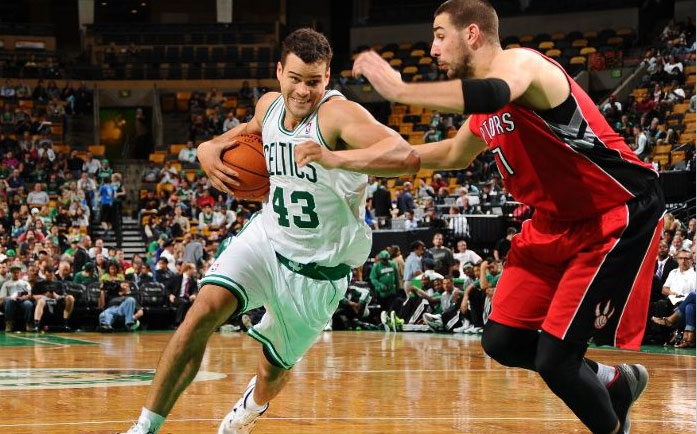What an original idea! It’s an article regarding Rudy Gay and his shot selection.
We get it. The cat is out of the bag. It’s literally the worst kept secret in the NBA. The players, coaches, general managers all know, and the media definitely knows.
Rudy Gay shoots an awful lot for someone who isn’t very efficient.
All the numbers back it up. He shot 41.6%/32.3%/81.4% from field goal, three-point range and free throws last season. Those three numbers translate into a true-shooting percentage of 49.4% (league average small forward: 54.8%). He somehow shot worse than Monta Ellis!
Gay compounds his poor shooting with over-shooting. His usage rate (% of possessions that Gay uses while he’s on the court) last season was 27.2%, which was just a smidgen behind Paul Pierce last season for 19th highest in the NBA. To put that into perspective. he used up a higher percentage of possessions than both LaMarcus Aldridge and Stephen Curry. Out of the top-50 usage rate leaders in the NBA, Rudy Gay posted the second worst true-shooting percentage.
—
When the Memphis Grizzlies signed Gay to a massive $82 million-5 year extension in 2010, the message was clear; it was his team, and for better or worse, he was the leader of the franchise.
That whole dynamic changed when he went down with a shoulder injury in the spring of 2011. The injury kept him out of the playoffs, and Gay was forced to sit on the sideslines as the Grizzlies found their true calling as a defensively-oriented grind-and-grind team. The offense adapted to running things through Marc Gasol and Zach Randolph in the post and they never looked back.
When Gay returned the following season, things were different. Somehow, the highest-paid player on the team had become an afterthought in the offense. He wasn’t as effective; his shooting numbers dipped (54.8% to 52.1% TS%), and people started to take notice.
Things took a turn for the worse last season when the team was sold to Robert Perra. He appointed Jason Levien as the CEO and brought in John Hollinger to serve as assistant general manager. Suddenly, the Grizzlies management team became much more analytically-focused.
The change in management, along with his burdensome contract, spelled the end for Rudy Gay’s time in Memphis. Less than two months into Hollinger’s tenure, Gay was shipped to the Raptors.
Many people criticized Bryan Colangelo for making the deal to acquire Gay, and rightly so. Not only was Gay owed a tonne of money, he was also in the midst of a terrible season shooting the ball (47.4 TS%). In defense of Gay, his supporters put out a popular narrative regarding why his shooting numbers were so low; with Marc Gasol and Zach Randolph clogging the paint, Gay was forced to shoot more from the outside, which deflated his shooting percentages.
Is this claim true? Is there any hope for Gay to return to shooting at a league-average rate once again? Let’s find out.
—
Presented below is the distribution of his shot attempts across the span of his career to-date. Rim refers to shots at the rim, short corresponds to shots from 3-9 feet out, mid (10-15 feet), long (16-23 feet) and three refers to three-point attempts. Year refers to the final year of that season (ie: 2007 refers to the 2006-2007 season).
We can spot one trend right away. Gay’s three-point attempts have steadily increased since 2010. Is this evidence of Memphis’ offense pushing Gay away from the hoop? Maybe, or maybe not. His career high in attempts at the rim per game came in 2010 and 2012, which suggests that he was still getting to the hoop, but those attempts dipped in 2011 and 2013. It’s hard to say based on this graphic alone.
What we can also look at is the percentage assisted on each of the shots. In theory, if Memphis was trying to push him out to the perimeter, he should have been assisted on a higher percentage of his shots from “long” and “three”. His %assisted values are below:
Uh-oh. The numbers are a mess, but there is one clear trend; he was assisted on less and less of his three-pointers as the years went on, so maybe the claim is false? Well, not so fast. His %assisted on mid and long shots also increased 2012 and 2013 (in Memphis) as compared to 2011, suggesting that the offense did try to push Gay to the perimeter.
Overall, based on his %assisted and shot attempt data, we cannot make any firm conclusions. Maybe Gasol-Randolph pushed Gay away from the rim, or maybe they didn’t.
What’s more interesting is that Gay’s percentages have stayed pretty constant over the last two seasons. However, his overall field goal percentage has declined. This suggests that his shooting woes were in large part a result of his shot-selection.
If it is a simple matter of shot selection with Gay, his shooting problem should be correctable with proper coaching. Whether he complies with said directives and makes changes to improve is another matter, but given that he’s roundly denounced as one of most overpaid players in the league, I hope Gay does everything within his power to improve.
In order to improve his shooting percentage, Gay should really focus on getting to the rim more often. He should also stop shooting so many long-two’s. As you can see from the chart below, Gay certainly does have some skills, notably in finishing from mid and short-range.
So there you have it. Based off the data that is available to us, we cannot accurately say for certain whether Memphis’ offense did, or did not affect his shooting percentages. However, it appears that the decline in his numbers is in large part due to changes in his shot-selection which suggests that with if he were to correct this, Gay could return to being a league-average shooter.
Fingers crossed.







